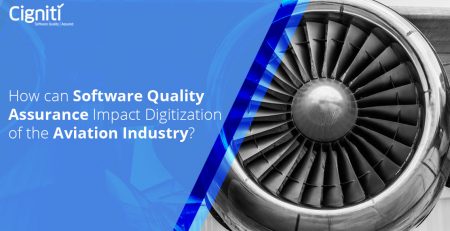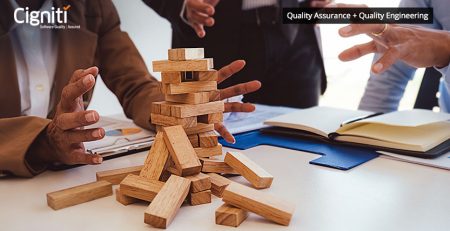How to Approach the Modernization of Quality Assurance
|
Listen on the go!
|
Digital transformation requires a holistic transition in the organizational culture and mindset. This transition would involve breaking the habit of throwing things over the fence. Instead, a collaborative team culture, a quality-driven mindset, and a customer-centric approach to transformational practices would be needed.
An enterprise cannot succeed in its digital transformation efforts without bringing quality into perspective. In fact, as enterprises are furthering their digitization, it is essential for them to adopt a more modern approach towards quality assurance.
Melissa Tondi, Quality Engineering leadership at E*TRADE, recently spoke on our podcast about adopting the modern quality assurance approach. This blog is an excerpt of their interview on the QATalks podcast.
Getting from quality assurance to quality engineering
Quality Engineering is about getting involved with the quality of the product right from the beginning.
Quality engineers are influential in building software before the software is built, says Melissa. A quality-assured engineering approach requires a mindset transition and a technology skill set. This means that individuals responsible for QE (Quality Engineering) should have the user advocacy and technical acumen for not only adopting but also embracing new tools and technology to ensure their efficient implementation
As opposed to assuring quality later in the SDLC (Software Development Life Cycle), quality engineering dictates shifting the left of testing activities. To help build overall quality in software, quality engineers participate at a very low level in the software development lifecycle, often even engaging in technical discussions with their project team counterparts.
This allows them to collaborate with all the members of a Agile project team or delivery team from an early phase and to be proactive in terms of errors and glitches.
Quality engineering is all about defect prevention and early defect detection.
Readiness of a company for implementing or upgrading its testing plan
As per Melissa, the biggest factor that determines a company’s readiness toward quality engineering and digital transformation depends on the ability of engineering leadership to understand the value of quality engineers or testers.
When leaders can see the value that QA (Quality Assurance) or QE can bring to their organizations, they become the biggest advocates for implementing the transformation. On the other hand, in organizations where QA is viewed as a second thought and does not get an equal seat at the table, it gets difficult to implement a successful testing program.
Additionally, when the value of QA is not perceived to be equal to that of the other members of delivery teams, the transformation from quality assurance to a quality engineering mindset becomes tricky to achieve.
To counter this situation, the ability to highlight and prove the continuous improvement that QA brings goes a long way in convincing the management.
Factors and challenges involved in the QA modernization journey
The key factor in modernizing QA is spreading the testing responsibility across the delivery team. Within the traditional QA strategies, testing used to be perceived and performed only as a part of test teams. They were handed off to the codes at the end of the development cycle and were responsible for writing and managing test codes.
Modernization of QA is writing a test while ensuring that the details are appropriate for the delivery teams and making the test centralized and accessible for the entire product team. The modern strategy for quality assurance requires being consultative with developers and making testing the responsibility of entire team.
Within large organizations, such best practices for QA modernization transformation necessitate a tremendous amount of change management skills and the ability to justify the change in terms of business value. As, with this transformation, QA teams start working closely with developers on a day-to-day basis, the roles and responsibilities of managers also change.
From being a line manager in a QA team, the people need to assume the role of a coach where they help and offer governance to ensure a seamless collaboration between various parts of the SDLC.
Implementing enterprise-wide test automation strategy
The key thing to focus here is to focus on what to automate instead of how much to automate.
Melissa says, “I have seen much less success when we have a number or percentage of test cases that indicate a higher quality automation strategy. One way that we counterbalance that is to have these specific criteria and guidelines for not only removing the numbers team from the equation but to make sure that we are all focusing on the right things to automate.”
“When we start embedding the quality engineers within the delivery team vs treating them as a matrix team where they are separate and they take their order and priority of work from another person that is sitting within the delivery team, we have increased the inefficiency of getting that work done.”
Melissa suggests, “if you start concentrating on work that makes the most value and sense to the delivery team, I found that you get much more buy-in and end support from the entire delivery team to support the efforts of test automation because it is tied to something that the entire delivery team is often tied to.”
In large organizations, multiple teams often have multiple different test automation frameworks, resulting in redundancy and a constant reinventing of the wheel. In such a case, an enterprise test automation platform would be implemented, making it possible to build test automation for multiple different applications that span across multiple technologies and tools.
In conclusion
As an ending remark, Melissa emphasizes the need to dispel the myth of proving one’s value as a Quality engineer. She says, “Our values should be very prominent and eminent with the things that we do. So, hopefully, the modernization of QA would move the fact that we need to prove our values constantly.
Our values should go along with our ability to collaborate without a delivery team to show value as part of our normal day-to-day activities and ideally, we would no longer need to be using our platform to continue to prove the value of QA because we already have proven that in our work.”
At Cigniti, we take pride in building enterprises of the future. We power the Digital Transformation journey of organizations by establishing comprehensive testing frameworks and strategies across the organizations’ digital value chain.
When we take the onus of an enterprise’s QA transformation, our first step is to understand the overall business objectives of the organization. We then align our QA activities such that they support the achievement of those objectives.
Cigniti’s Quality Engineering services cover the Software Testing Life cycle, Test Consulting and Test Advisory services, Test Implementation, and Managed Testing services, including Test Environment Management and Test Data Management.
Leveraging process frameworks, methodologies, and tools, we help customers across various industries achieve first-time-right solution release quality improvements and deliver a superior customer experience.





Leave a Reply